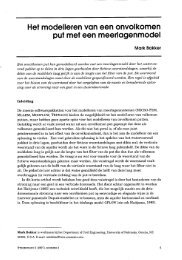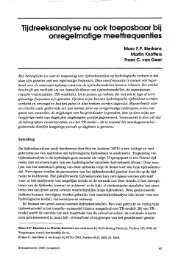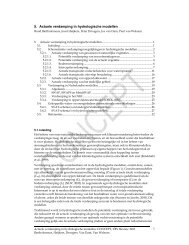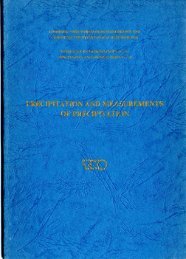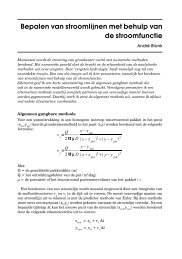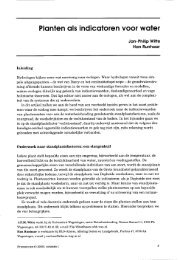Hydro-ecological relations in the Delta Waters
Hydro-ecological relations in the Delta Waters
Hydro-ecological relations in the Delta Waters
Create successful ePaper yourself
Turn your PDF publications into a flip-book with our unique Google optimized e-Paper software.
hierarchical position. Tn <strong>the</strong> egtuar<strong>in</strong>e situation <strong>the</strong> water regime is<br />
one of <strong>the</strong> met essential factors detemis<strong>in</strong>g processes <strong>in</strong> soil.<br />
gegstation and fa-. The relation between <strong>the</strong> average salt<br />
concentation and <strong>the</strong> distrlbotion of some vegetation types is a sood<br />
example wf this dom<strong>in</strong>ance (Big. 3).<br />
Ae saon ae great changes occur <strong>in</strong> <strong>the</strong> outer cmpartntents of <strong>the</strong> made1<br />
/by human <strong>in</strong>terference of o<strong>the</strong>r), this has impertaut consequences for<br />
<strong>the</strong> hierarchically lowar parts. Cholllges <strong>in</strong> <strong>the</strong> lower camgartments have<br />
Lesa cons+quenees on <strong>the</strong> system a5 a whule. Figure 4 (derived from<br />
Reftlnk, 1979) gzves a good exwle nf such a situation. In <strong>the</strong> wet<br />
autnmn of 1961 severe waterlogged conditions occurred on a higher salt<br />
marsh <strong>in</strong> <strong>the</strong> Grevd<strong>in</strong>gen estaary. This was <strong>the</strong> primclry cau6e for a<br />
die-bmk of <strong>the</strong> vevetation of Halimione pnztulacoides on that WSh. In<br />
<strong>the</strong> long run <strong>the</strong>re was, however, no chenge of <strong>the</strong> saltmarsh ecssyatem<br />
as a whole and after sonre years <strong>the</strong> orfgmal vegetation could recover.<br />
The erosion of a tidal flat or a salt marsh and <strong>the</strong> developmt of new<br />
onea elsewhere <strong>in</strong> <strong>the</strong> same tidal system are an exmple of <strong>the</strong> same<br />
e).clic dynaunica on a larger scale of space and tb.<br />
The con$truction af <strong>the</strong> DelCa Works resulted <strong>in</strong> quite different types<br />
of <strong>ecological</strong> dynamics. The water syetm a5 a whole changed t~tally and<br />
resulted <strong>in</strong> a cmplere new and irrevexsihle development of water and<br />
lad (Beeft<strong>in</strong>k. 1987). After <strong>the</strong> fidehtx~g of rhe dmh many of <strong>the</strong><br />
estuafkre plants and animals died and nerv species had to celonize <strong>the</strong><br />
disturbed ecobystems. Id Che beg<strong>in</strong>n<strong>in</strong>g <strong>the</strong> dam<strong>in</strong>ar<strong>in</strong>g species <strong>in</strong> <strong>the</strong><br />
vegetation changed from year tcr pear. Later on changes took place much<br />
more gradually. There were also marked differexices between habitats.<br />
The vegetation of <strong>the</strong> lowar salt mrshes died totally sith<strong>in</strong> two or<br />
three years. The higher salt marshes were well adapted 60 less frequent<br />
<strong>in</strong>undations and vegetation changed gradually after <strong>the</strong> disappearance of<br />
<strong>the</strong> tides. In tha reed marshes and willow woedlands of <strong>the</strong> brackish and<br />
fresh estuaries <strong>the</strong> same pattern occurred. Theae vegetattons actually<br />
did not die, btrt durtng some S to l@ years after damm<strong>in</strong>g <strong>the</strong>ir species<br />
composition and structure changed very mufh.





